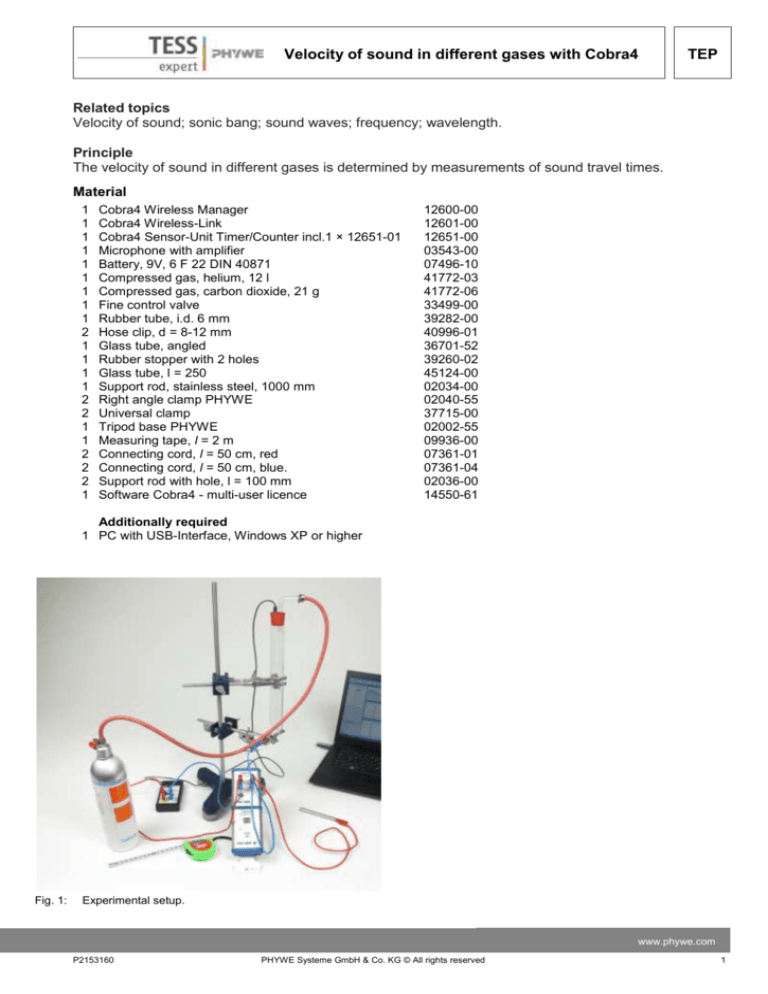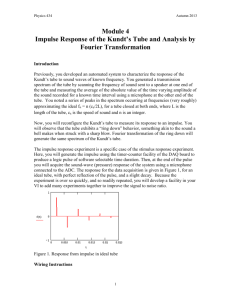
Velocity of sound in different gases with Cobra4
TEP
Related topics
Velocity of sound; sonic bang; sound waves; frequency; wavelength.
Principle
The velocity of sound in different gases is determined by measurements of sound travel times.
Material
1
1
1
1
1
1
1
1
1
2
1
1
1
1
2
2
1
1
2
2
2
1
Cobra4 Wireless Manager
Cobra4 Wireless-Link
Cobra4 Sensor-Unit Timer/Counter incl.1 × 12651-01
Microphone with amplifier
Battery, 9V, 6 F 22 DIN 40871
Compressed gas, helium, 12 l
Compressed gas, carbon dioxide, 21 g
Fine control valve
Rubber tube, i.d. 6 mm
Hose clip, d = 8-12 mm
Glass tube, angled
Rubber stopper with 2 holes
Glass tube, l = 250
Support rod, stainless steel, 1000 mm
Right angle clamp PHYWE
Universal clamp
Tripod base PHYWE
Measuring tape, l = 2 m
Connecting cord, l = 50 cm, red
Connecting cord, l = 50 cm, blue.
Support rod with hole, l = 100 mm
Software Cobra4 - multi-user licence
12600-00
12601-00
12651-00
03543-00
07496-10
41772-03
41772-06
33499-00
39282-00
40996-01
36701-52
39260-02
45124-00
02034-00
02040-55
37715-00
02002-55
09936-00
07361-01
07361-04
02036-00
14550-61
Additionally required
1 PC with USB-Interface, Windows XP or higher
Fig. 1:
Experimental setup.
www.phywe.com
P2153160
PHYWE Systeme GmbH & Co. KG © All rights reserved
1
TEP
Velocity of sound in different gases with Cobra4
Task
Determine the speed of sound in different gases.
Setup and procedure
For air and helium the microphone amplifier is connected to the Stop and
Earth jacks of Timer 1 in accordance with Figs. 1 and 2.
For carbon dioxide the entire setup can be removed from the support base,
turned 180°, and again clamped in the support base.
Connect the Cobra4 Wireless Manager to the USB interface of the computer
and the Cobra4 Sensor-Unit Timer/Counter on the Cobra4 Wireless-Link.
Start “measure” and load the experiment. (Experiment > Open experiment).
All pre-settings that are necessary for value recording are now carried out.
Click on
in the icon strip to start measurement. A pulse of sound is generated by striking two metal rods against each other. By doing so, an electrical contact is simultaneously closed; this starts Timer 1. After the sound has
travelled the distance s, the pulse of sound is registered by the microphone;
in this manner, Timer 1 is stopped. One obtains the sound travel time t or also immediately the speed of sound v = s / t if the path distance has been
previously entered (Fig. 3). Ensure that the sound pulse is generated at approximately the same height in which the microphone is located in order to
ensure that the vertical distance between the sound source and the microphone is in reality the distance that the sound pulse must travel. The dis- Fig.2: Circuit diagram.
tance s is the distance from the front side of the microphone capsule to the
side of the clamped-in metal rod facing the microphone.
Tap the free metal rod on the side of the clamped-in rod that faces away
from the microphone. Subsequently, the measured speed of can be read off
and the timer is stopped. Occasionally, the timer immediately restarts after
termination of the measurement because additional start pulses were sent to
Timer 1 as a result of the metal rod’s rebounding after having been struck. In
this case, terminate the measurement process with a noise and then perform another measurement.
Repeat the measurement approximately 10 to 15 times and use the mean of
the measurements for the speed of sound. Subsequently fill the glass tube Fig.3: Path distance.
with helium, close the valve, and again record 10 to 15 measurements.
Remove the support rod from the support base, turn it 180° and again clamp it in the support base. Now
fill the glass tube with CO2 gas; close the valve and again record 10 to 15 measurements.
Attention:
The reproducibility of the speed of sound measurements provides information on whether the glass
tubes are completely filled with the test gas. If, for example, on further filling with helium the speed of
sound continues to rise, there is still an air-helium-mixture in the tube. However, one must take the fact
that helium defuses around the rubber stopper and escapes into consideration; thus, a few minutes after
the valve has been closed the speed of sound again decreases.
The tube is completely filled with CO2 gas when the measured speed of sound has reached a minimum.
Results
A typical measurement series for the distance s = 0.263 m in the glass tube and in the rubber stopper is
given in Table 1:
Air v (m/s)
341.442
345.492
350.060
2
He v (m/s)
963.610
931.303
947.406
PHYWE Systeme GmbH & Co. KG © All rights reserved
CO2 v (m/s)
304.368
297.998
304.935
P2153160
Velocity of sound in different gases with Cobra4
356.051
338.269
347.554
337.877
334.386
350.904
356.926
344.675
345.492
345.903
338.663
348.385
345(2)
at 344
Mean v (m/s)
Literature
value,
20 °C v (m/s)
Table 1: Example measurements.
939.286
958.455
939.286
944.684
947.406
958.455
936.610
947.406
941.977
969.764
950.145
944.684
946(3)
1007
TEP
302.401
306.361
301.011
297.187
301.011
304.085
302.122
301.843
302.401
303.241
300.183
303.803
302(1)
266
The speed of sound in gases is a function of the adiabatic exponent cp/cv. The latter is dependent on the
structure of the molecule of the investigated gas. For this reason, the speed of sound in different gases
at constant temperature is different as a rule.
Remarks
If Timer 1 does not stop measuring despite clearly audible tone, it may be necessary to adapt the output
voltage of the microphone amplifier to the volume of the loudspeakers.
During the measurement no background noises may occur, since they would also be registered by the
microphone and could falsify the measurement. Such background noises appear as sound travel times
that are too short or as excessively high apparent speeds of sound and can be thus easily recognised.
During the measurement the valve on the gas-bottle must be closed, because the noise of the escaping
gas is registered by the microphone and causes Timer 1 to stop.
The restrained metal rod must be directly under (or over) the opening of the glass tube but not in contact
with it. In case of direct contact the pulse of sound also passes through the glass material and falsifies
the measurement. If the distance between the rod and the tube is too large, the pulse of sound passes
through an excessively thick layer of air above or below the open end of the tube; as a result the speed
of sound will also be erroneously determined.
www.phywe.com
P2153160
PHYWE Systeme GmbH & Co. KG © All rights reserved
3
TEP
Velocity of sound in different gases with Cobra4
Space for notes:
4
PHYWE Systeme GmbH & Co. KG © All rights reserved
P2153160








